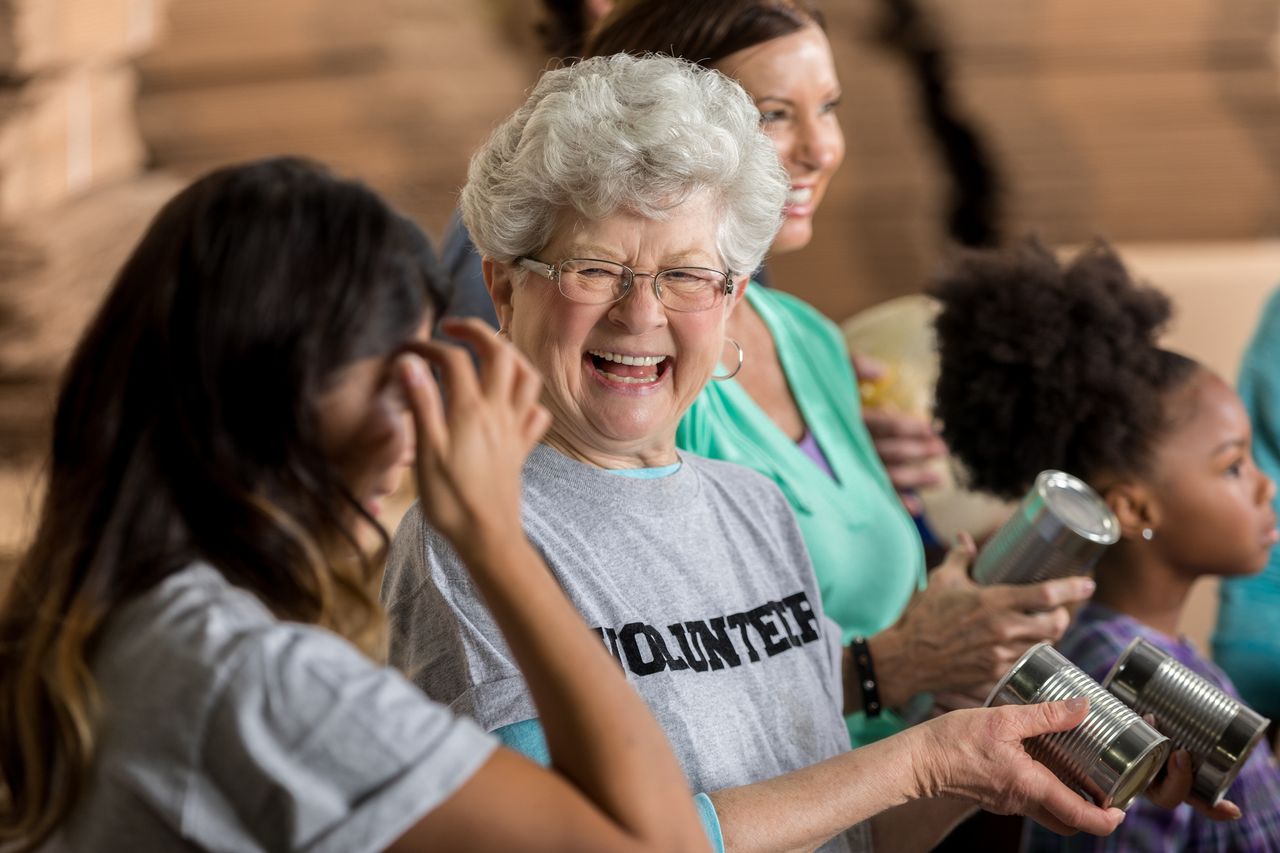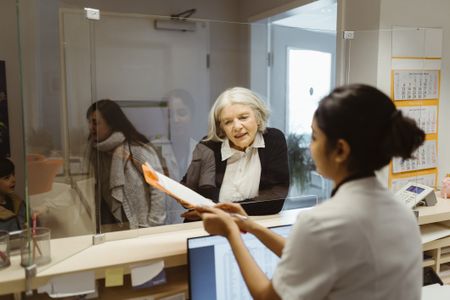Senior Volunteers Go Virtual to Help Charities
Retirees have found numerous ways to continue to support beloved causes during COVID-19.

Phil Chin loved being an active member of his community in Falmouth, Maine. The 71-year-old taught safe-driving and fraud prevention courses for AARP, participated in community theater and sang in the church choir. Then COVID-19 upended these cherished activities.
Undaunted, Chin pivoted to volunteering virtually. State regulations prohibited teaching the safe-driving courses online, but the fraud prevention classes could be done remotely. Meanwhile, the theater mounted virtual productions of “It’s a Wonderful Life” and “A Christmas Carol.” Chin also edited together audio of the choir’s individual voices to create choral pieces. “Teaching, acting and singing when there are no live audiences can be a challenge,” he says. “But in the end, the results are meaningful and satisfying.”
Chin represents the struggle many volunteers have faced during the pandemic—adapting to a virtual format. Before the pandemic, only 19% of volunteers participated from a distance, compared with 65% during the coronavirus outbreak, according to Fidelity Charitable, an independent public charity and the nation’s largest grant maker, with $5.2 billion in donor-recommended grants. “With so much upheaval and uncertainty, people are motivated to do something productive and positive,” says Mark Silverman, CEO of Amava, a platform that matches volunteers with charities.

Sign up for Kiplinger’s Free E-Newsletters
Profit and prosper with the best of expert advice on investing, taxes, retirement, personal finance and more - straight to your e-mail.
Profit and prosper with the best of expert advice - straight to your e-mail.
Amava saw a 433% increase in virtual volunteering in 2020. “Against the backdrop of the work-from-home revolution, no nonprofit organization that relies on the efforts of volunteers can ignore the fact that people are looking for new ways to volunteer,” Silverman says.
Charities Took a Hit During COVID-19
Nonprofits depend on the free labor of volunteers. Each year, approximately 63 million Americans donate their time, an average hourly value of $27.20, according to Independent Sector, an organization for nonprofits, foundations and corporate giving programs. When the pandemic hit, those volunteer hours dropped dramatically. Fidelity Charitable found that 45% of volunteers contributed fewer hours and 21% stopped altogether. One reason is lack of knowledge: 64% weren’t sure where to find virtual opportunities. “Charities essentially lost access to millions of dollars in volunteers’ time,” says Amy Pirozzolo, Fidelity Charitable’s head of donor engagement.
The hardest hit organizations were those that rely on seniors and require close contact, such as food pantries and nursing homes, says Marian Z. Stern, principal of Projects in Philanthropy, a New York consulting firm. “Many of the volunteers at these locations are senior citizens themselves, so they didn’t feel safe continuing on site, not to mention that nursing homes were closed to all outsiders anyway,” Stern says. “Additionally, many pantries are hosted by churches and synagogues, and they simply didn’t have the space to have their volunteers remain socially distant.”
Some organizations lost so much of their unpaid workforce that they had to hire replacements. For instance, Meals on Wheels hired drivers after losing many volunteer drivers early in the pandemic.
To help organizations cover these expenses, some people who can’t volunteer their time may want to donate money instead. “If there is not a great match or way for you to volunteer, consider how increased financial support might help your favorite charity offset the loss in volunteer support,” Pirozzolo says.
Finding the Right Volunteer Opportunity
Because volunteering is a huge commitment, research the charities that address the causes you care about, and then ask these nonprofits how you can help, whether virtually or in some other socially distant way. “Putting a bit of thought and time into it on the front end makes for more productive commitments and connected volunteers,” Amava’s Silverman says. “A volunteer who goes into an experience with a clear set of goals and a defined purpose usually makes a great contribution.”
Amava designed a one-hour process to help participants identify the volunteer opportunities that fit them best. Called a Circle, the process includes a list of questions, a group brainstorming session and personalized curated options for each person. Sometimes those options involve using existing skills in new ways.
At the National Cathedral in Washington, D.C., the extra demands of providing emotional support and pastoral care during the pandemic overwhelmed the paid staff and clergy. Mary Wright Baylor, 67, of Springfield, Va., was able to help the congregation using her skills as a retired psychiatric parish nurse with training in end-of-life care. She has hosted phone and video calls with parishioners diagnosed with COVID-19.
In one difficult situation, a parishioner contracted COVID-19 in a nursing home, where she was isolated. Baylor talked and prayed with the woman over an iPhone multiple times. As a licensed pastoral leader, Baylor was even able to administer last rites virtually. She held an outdoor memorial service at another congregant’s home, which she felt was an honor at a time when so many families are unable to memorialize a loved one. “I’ve been a resource in that capacity for our congregation,” she says. “It’s been an extraordinary privilege and a great outlet for me because it’s so frustrating not to help as a nurse.”
Brainstorming New Ways to Help
Marijke Vroomen Durning, a 59-year-old writer in Montreal, used to help at housing shelters and walk dogs for the Society for the Prevention of Cruelty to Animals. Now that she can’t give her time in person, she’s started making masks and giving them to people for free—in return for a donation to her local food bank. “They received donations from as far away as Hawaii and Sweden,” Durning says. “I felt very satisfied with my contribution, and it was just as meaningful as other volunteer work I’ve done. Sometimes I see people in the neighborhood wearing one of my masks and it makes me smile.”
Brenda Moss, 59, of Lynchburg, Va., volunteers with Everytown for Gun Safety by sharing the story of her son Shawn’s death from gun violence. Because of the pandemic, she can’t speak to crowds of people or meet in person with families mourning a loss. Moss typically hosts the Shawn Moss Angel Tree, a holiday season event that includes a sit-down meal and gifts for families affected by gun violence. Last year, because of social distancing requirements, the holiday meal was replaced with lunches to go, and only one family at a time was allowed in the building to pick up their gifts. “The pandemic has changed the way things are done. I have still found a way to deliver smiles,” she says.
Because it will take time before things return to normal, charities will need to continue brainstorming new and ingenious ways to fulfill their missions. “The long-term implications could be severe, with volunteers not returning in force until 2022,” Stern says. “I’ve seen some very creative virtual volunteering, especially those centering on children. Those who used to visit schools to read to young children, for example, immediately pivoted to reading on Zoom, often adding flourishes of costumes and story-related backgrounds.”
In a sense, volunteerism has returned to its roots during the pandemic, Pirozzolo says. In the early days of the nation, philanthropy consisted of neighbors helping each other, often centered around the church. “We are seeing this now in abundance,” Stern says. “Neighbors are checking in on elderly neighbors, individuals are bringing food to shut-ins, [and] there are drive-by visits to people suffering from disease.” That’s what philanthropy is about—helping others in spite of the obstacles.
Are You a Good Match to a Charity?
The best relationships between volunteers and nonprofits are those that are in sync. You’ll have a more satisfying experience if you and the organization where you volunteer share the same ideals and have agreed from the outset what the expectations on both sides are. Gauge whether you and the charity are a good match by asking these six questions, which are meant to elicit not just a candid conversation but also a little soul-searching on your part.
- Do you believe in the organization’s charitable mission?
- Have you clarified the time commitment and expectations?
- Are your skills and knowledge a good fit with the organization’s needs?
- Are you hoping to learn something new or exercise your existing abilities?
- Do you prefer interacting with the nonprofit’s beneficiaries or staying behind the scenes?
- Is connecting with a cohort of volunteers important to you?
Get Kiplinger Today newsletter — free
Profit and prosper with the best of Kiplinger's advice on investing, taxes, retirement, personal finance and much more. Delivered daily. Enter your email in the box and click Sign Me Up.
Katherine Reynolds Lewis is an award-winning journalist, speaker and author of The Good News About Bad Behavior: Why Kids Are Less Disciplined Than Ever – And What to Do About It. Her work has appeared in The Atlantic, Fortune, Medium, Mother Jones, The New York Times, Parents, Slate, USA Today, The Washington Post and Working Mother, among others. She's been an EWA Education Reporting Fellow, Fund for Investigative Journalism fellow and Logan Nonfiction Fellow at the Carey Institute for Global Good. Residencies include the Virginia Center for the Creative Arts and Ragdale. A Harvard physics graduate, Katherine previously worked as a national correspondent for Newhouse and Bloomberg News, covering everything from financial and media policy to the White House.
-
 RMD Deadline April 1: Five Tax Strategies to Manage Your 2025 Income
RMD Deadline April 1: Five Tax Strategies to Manage Your 2025 IncomeTaxable Income The April 1, 2025, deadline for required minimum distributions (RMDs) is fast approaching for retirees who turned 73 in 2024.
By Kelley R. Taylor Published
-
 Rising AI Demand Stokes Undersea Investments
Rising AI Demand Stokes Undersea InvestmentsThe Kiplinger Letter As demand soars for AI, there’s a need to transport huge amounts of data across oceans. Tech giants have big plans for new submarine cables, including the longest ever.
By John Miley Published
-
 10 Cheapest Small Towns to Live In
10 Cheapest Small Towns to Live InThe cheapest small towns might not be for everyone, but their charms can make them the best places to live for plenty of folks.
By Dan Burrows Published
-
 457 Plan Contribution Limits for 2025
457 Plan Contribution Limits for 2025Retirement plans There are higher 457 plan contribution limits for state and local government workers in 2025. That's good news for state and local government employees
By Kathryn Pomroy Last updated
-
 Medicare Basics: 11 Things You Need to Know
Medicare Basics: 11 Things You Need to KnowMedicare There's Medicare Part A, Part B, Part D, Medigap plans, Medicare Advantage plans and so on. We sort out the confusion about signing up for Medicare — and much more.
By Catherine Siskos Last updated
-
 The Seven Worst Assets to Leave Your Kids or Grandkids
The Seven Worst Assets to Leave Your Kids or Grandkidsinheritance Leaving these assets to your loved ones may be more trouble than it’s worth. Here's how to avoid adding to their grief after you're gone.
By David Rodeck Last updated
-
 SEP IRA Contribution Limits for 2025
SEP IRA Contribution Limits for 2025SEP IRA A good option for small business owners, SEP IRAs allow individual annual contributions of as much as $69,000 in 2024 and $70,000 in 2025..
By Jackie Stewart Last updated
-
 Roth IRA Contribution Limits for 2025
Roth IRA Contribution Limits for 2025Roth IRAs Roth IRA contribution limits have gone up. Here's what you need to know.
By Jackie Stewart Last updated
-
 SIMPLE IRA Contribution Limits for 2025
SIMPLE IRA Contribution Limits for 2025simple IRA The SIMPLE IRA contribution limit increased by $500 for 2025. Workers at small businesses can contribute up to $16,500 or $20,000 if 50 or over and $21,750 if 60-63.
By Jackie Stewart Last updated
-
 457 Contribution Limits for 2024
457 Contribution Limits for 2024retirement plans State and local government workers can contribute more to their 457 plans in 2024 than in 2023.
By Jackie Stewart Published